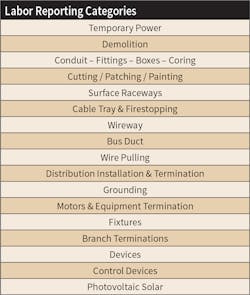Why is a weekly meeting so vital to the success of an electrical contractor? Because depending on the size of the company, salaries for estimators are typically one of the largest overhead expenses. To maximize estimating resources, the chief estimator must meet with the estimating team regularly (weekly is recommended). Although it may seem elementary and unnecessary, it’s amazing what a difference this short weekly gathering can make in the long-term success of your electrical projects.
The meeting must be both purposeful and planned — with the top priority addressing current and future estimates. Staying on top of current and future estimates will prevent estimators from being overloaded with work. When an estimator has more work than he or she can properly handle, estimating quality will decrease.
The weekly meeting, which should ideally be held at the same time each week to make it a routine, can also be beneficial when a review of successful bids and completed projects are discussed. A study of your “estimating history” will provide valuable information for estimators handling current and future projects.
Current estimates
Let’s take a look at how the chief estimator should handle the current bid schedule. He or she must know the abilities of the estimating staff. Since some employees are inevitably unwilling to ask for help, a regular meeting provides an environment for communication between estimators. Mistakes will occur when there’s not enough time allowed to complete an estimate. Having a regular meeting provides the estimator with the opportunity to express time constraint concerns in completing an estimate.
Obviously, not all projects are the same. So, on occasion, a project will have a task or piece of equipment that is not routine. The estimator must evaluate the impact of any unique task or contractual obligation and bring it to the attention of the chief estimator. Making informed decisions rather than educated guesses should protect a contractor from estimating something incorrectly. When the chief estimator doesn’t make time to provide support and assistance to the estimating team, the quality of the estimates is sure to decline. This will show in the bid results — low bid prices with little, if any, profit or extremely high bid prices, which result in a loss project.
At the meeting, the chief estimator must be available to the estimating team for discussions about areas of work that may involve risks. One of the most important responsibilities of the estimator is to identify material and labor risks on a project. He or she also must ask questions, offer assistance, and make sure all bids are on schedule. Good communication between estimators and the chief estimator will minimize pressure and mistakes on bid day.
Future estimates
As the popular saying goes, “Plan your work, and work your plan.” Some projects are more attractive than others. Understanding a project’s schedule, phasing, and location can be important factors in deciding which projects to bid on. The wise electrical contractor will try to backlog work that best fits its ability to perform.
Based on each estimator’s current work load, the chief estimator should assign upcoming estimates based on their skill and ability. Sufficient time must be given to estimators so they can properly bid projects and balance work load. Piling on work will decrease accuracy and production, not increase it.
Completed projects
An electrical contractor should want to know why profit was made or monies were lost. Tracking a project’s labor by system, building, and floor will provide valuable information for future bids. A contractor loses valuable information when he fails to track labor by categories, which could include: conduit and hangers, panels and branch circuits, distribution feeders, luminaires, fire alarm equipment/systems, etc. Without this information, you have no idea where to adjust your labor units on future bids.
Labor units are established through project studies. Time is tracked for specific installation tasks. For example, two electricians spend one day to install 16 luminaires. This equates to 16 labor hours. The total number of luminaires is divided into the total labor hours it took to install the equipment. This translates into one hour per luminaire. Let’s say, on this project, it actually took the electricians 32 hours to install the luminaires. This means your labor unit is 100% off!
A contractor must have a plan in place to capture this data and provide feedback to the estimating department. This allows changes to be made in the way future projects are labored.
On projects where conduit work is a large percentage of the total labor hours, extra care must be exercised. If the conduit work is 50% or more, a careful analysis must be made of the labor units assigned to each component in the conduit system. Having an accurate labor reporting system of completed projects will assist the estimator in adjusting his or her current estimate.
For example, if you had a 20,000-hour project with 10,000 hours in conduit work and a 15% reduced labor unit, the result would be a large profit loss. Fifteen percent labor loss equals 1,500 labor hours. Fifteen-hundred labor hours multiplied by an average labor rate of $65/hr equates to a $97,500 loss in profit.
It’s crucial that a contractor’s project foreman provide accurate tracking of each electrician’s labor hours on the job. It is best to track the labor by a predetermined set of cost codes or categories. This labor reporting is vital in assisting the estimator in adjusting labor units for future projects being bid. It’s up to each contractor to decide the best and most appropriate categories for his or her specific company. The Table shows a list of possible labor reporting categories a contractor might use.
Kiper is an independent electrical estimating consultant and trainer based in Niagara Falls, N.Y. He can be reached at [email protected].
About the Author
Don Kiper
Independent Electrical Estimating Consultant
With more than 35 years of experience as a construction electrician, industrial maintenance electrician, foreman, estimator, estimating manager, and project manager, Don has used what he learned to lead in the implementation of estimating software with three electrical contractors where he has worked. Don has 17 years of experience in the construction field and 18 years of office experience and he has personally estimated over $700 million dollars in electrical projects.

